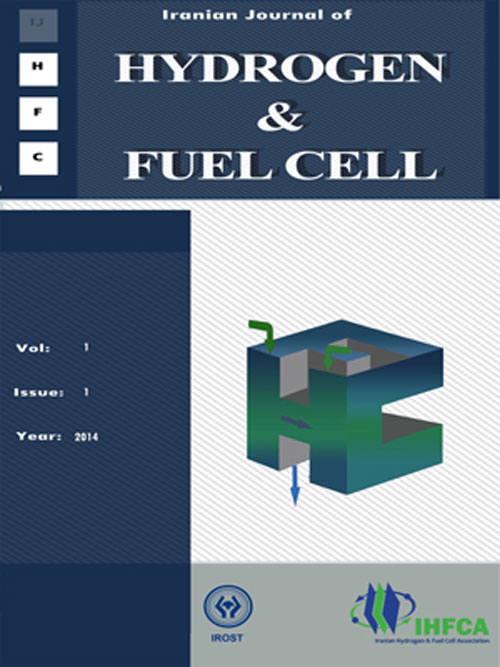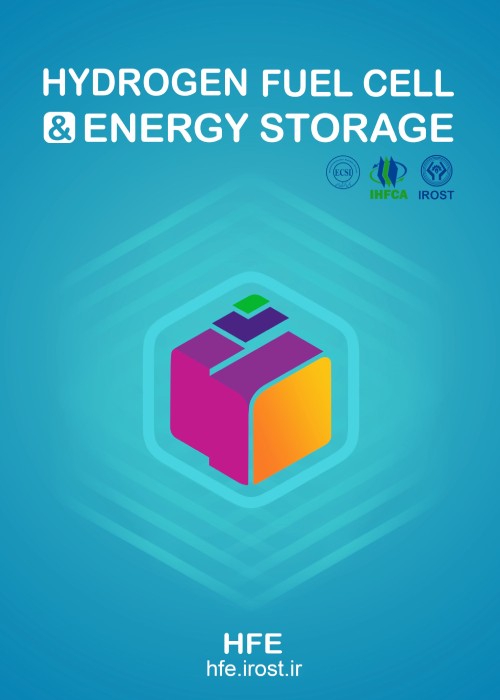فهرست مطالب

Journal of Hydrogen, Fuel Cell and Energy Storage
Volume:4 Issue: 1, Winter 2017
- تاریخ انتشار: 1395/12/01
- تعداد عناوین: 6
-
-
Pages 1-11In this study, the activity, stability and performance of carbon supported platinum (Pt/C) electrocatalyst in cathode and carbon supported Pt and ruthenium (PtRu/C) electrocatalyst in anode of direct methanol fuel cell (DMFC) were studied. The Pt/C and PtRu/C electrocatalysts were prepared by impregnation reduction method. The β-D-glucose was used as protection agent to reduce the particle size and improve performance of prepared electrocatalysts. The prepared electrocatalysts were characterized by using X-ray diffraction (XRD) and transmission electron microscopy (TEM) techniques. The results of XRD and TEM showed that the average particle size of metals in prepared electrocatalysts is between 2-3 nm. The cyclic voltammetry (CV), electrochemical impedance spectroscopy (EIS) and chronoamperometry were used to investigate electrooxidation of methanol and electrocatalytic activity of prepared electrocatalysts. The results showed that PtRu/C electrocatalyst has better activity in methanol condition due to its smaller average particle size of nanoparticles, superior activity for methanol oxidation and its higher carbon monoxide (CO) tolerance. The single DMFC cell consisted of protected electrocatalysts exhibited a 28 % increase in the peak power density in room temperature, with the maximum peak power density of 22.13 mW cm-2.Keywords: Electocatalyst, Impregnation reduction method, Protection agent, Direct methanol Fuel cells
-
Pages 13-26In this study pre-combustion capture of carbon dioxide from hydrogen was performed using a 5A zeolite adsorber. A one column thermal pressure swing adsorption (TPSA) process was studied in the bulk separation of a CO2/H2 mixture (50:50 vol%). The adsorption dynamics of the zeolite bed were investigated by breakthrough experiments to select the suitable range for operational factors in the design of experiments. Combined effect of three important variables namely, adsorption time, purge to feed ratio, and regeneration temperature on hydrogen purity, recovery and productivity were investigated in the TPSA process using Response Surface Methodology (RSM). Predicted models show an interaction between adsorption time and regeneration temperature in the range that the experiments were performed. Optimization of the TPSA process was performed based on the goal of responses. As hydrogen purity has the large impact with respect to hydrogen recovery and productivity in industry, the optimum condition was proposed based on maximum purity of hydrogen. In this condition, predicted values for adsorption time, purge to feed ratio, and regeneration temperature were 7.99 min, 0.2, and 204 °C, respectively. Predicted values of responses for hydrogen purity, recovery, and productivity were 99.88%, 50.71%, and 1.32, respectively. Acquired models were validated by experimental data in predicted conditions and actual responses were very close to predicted values. These results confirmed the accuracy of obtained models.Keywords: Response surface methodology, Pressure Swing Adsorption, CO2 capture, Zeolite 5A, Hydrogen purification
-
Pages 27-35In this paper we report on a lithium ion battery (LIB) based on improved olivine lithium iron phosphate/carbon (LiFePO4/C) as cathode material and LiNa0.02K0.01FePO4/C synthesized by sol-gel method and TiO2 nanotube arrays (TNAs) with an anatase phasesynthesized through anodization of Ti foil as an anode electrode. Crystallographic structure and surface morphology of the cathode and anode materials were studied using X-ray diffraction (XRD) and scanning electron microscopy (SEM). The electrochemical characterization of the Li-LiNa0.02K0.01FePO4/C and Li-TNAs half-cells and LiNa0.02K0.01FePO4/C-TNAs full-cell configuration was carried out through cyclic voltammetry (CV) and charge/discharge analysis. The operating potential and the first discharge capacity of the full cell were about 1.7 V and 127 mAhg-1 (at 0.5 C), respectively, and stayed stable for up to 100 cycles with limited capacity fading. Therefore, this system (full-cell) is characterized by enhanced electrochemical properties, a high safety level, remarkable environmental compatibility, long life and low cost. The preliminary results in this work suggest that the system may be suitable for using as environmental friendly hybrid, electric vehicles (EVs), and an alternative energy storage system for powering safe and stationary applications.Keywords: Lithium-ion battery (LIB), Lithium iron phosphate, TiO2 nanotube arrays (TNAs), full-cell, electric vehicles (EVs)
-
Pages 37-52In this article three dimensional modeling of a planar solid oxide fuel cell (SOFC) was investigated. The main objective was to attain the optimized cell operation. SOFC operation simulation involves a large number of parameters, complicated equations, (mostly partial differential equations), and a sophisticated simulation technique; hence, a finite element method (FEM) multiphysics approach was employed. This can provide 3D localized information within the fuel cell. In this article, SOFC efficiency improvement has been investigated based on optimization parameters. For the first time, radiation heat transfer equations were considered in addition to the effects of conduction and convection heat transfer in 3D simulation in a planar cell. This effect has been neglected in all previous SOFCs simulations. Based on the proposed equations, the emissivity effect on temperature distribution was studied. The maximum location is where temperature and hydrogen mass fraction are high in the fuel. Radiation heat transfer between the channel wall and the fluid and also in between the cell and ambient outside have been employed. Minimizing the ohmic drop by optimizing the cathode layer thickness is another new aspect in this research. According to this optimization simulation, it is possible to achieve maximum current density.Keywords: Solid Oxide Fuel Cells, Anode-supported, Modeling, Radiation heat transfer, Optimization simulation
-
Pages 53-68The proton exchange membrane (PEM) fuel cell is a green energy producer which converts chemical energy to electricity in high yield. Alternatively, the vanadium redox flow battery (VRB) is one of the best rechargeable batteries because of its capability to average loads and output power sources. These two systems are modeled by Nernst equation and electrochemical rules. An effective energy generator should be able to operate with a new type of energy storage mechanism which would increase the capacity and stability of the comprehensive system using the proposed integrated system. Therefore, in this presented study a VRB as an energy storage system along with a PEM fuel cell has been modeled for peak shaving purpose. A transient model was created as a novel approach to predict cell operation condition, based on electrochemical equations and the battery equivalent circuit concept. Results showed that charging the VRB for one day with surplus produced electricity from the fuel cell will increase the total delivered power of the integrated system up to 50%.Keywords: Vanadium Redox Battery, Proton exchange membrane fuel cell, Nernst Equation, Transient Model, Energy Storage System
-
Pages 69-83In this paper, three innovative 3-D geometries for flow fields of cathode and anode have been developed to investigate the comparative impact of increasing the multiplicity of the involved anode-cathode channel surface contact on the efficiency of electrochemical reaction via the same membrane electrode assembly (MEA) active area. In the introduced new models, each anode channel includes two, three and four cathodes while the convectional model include a one to one connection. The governing equations consist of mass, momentum and energy conservation. In addition, the species transport and the electric/ionic fields were solved numerically using the finite volume method under the assumptions of steady state and non-isothermal fluid flow. Simulation results revealed that increasing the multiplicity of the anode-cathode involved surface of reactants channel leads to current and power density enhancement due to the improved opportunity of reactants penetration and less concentration losses. Also, a considerable reduction of mono-cell volume size and costs for the new models in comparison with the base design was achieved.Keywords: PEM fuel cell, Power density, reactive area, electrochemical reaction


